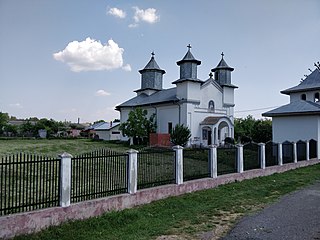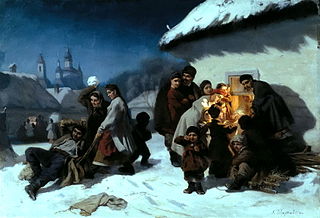By region
This custom varies depending on the ethnographic region. In northern Transylvania, children go with sorcova from house to house, wishing health in exchange for local delicacies (cozonac, colac, apples, nuts). In urban areas, it is common for children to receive cash, candies or oranges.
An interesting form of custom can be found in the west of the country (village of Bucium, Bihor County). Children have a fir tree branch decorated with tinsel, candies and țingălău (bell). Whoever does not have a fir tree can go with a stick wrapped in tinsel, on which are held three or four țingălăi. When they enter the house, those with fir tree sing and those with the stick hit rhythmically the floor after melody. Commonly, every child has his sorcova. While reciting, sorcova is moved in the rhythm of versification, sometimes marked by the sound of the bell.

Christmas in Poland is a major annual celebration, as in most countries of the Christian world. The observance of Christmas developed gradually over the centuries, beginning in ancient times; combining old Polish pagan customs with the religious ones introduced after the Christianization of Poland by the Catholic Church. Later influences include the mutual permeating of local traditions and various folk cultures. It is one of the most important religious holidays for Poles, who follow a somewhat strict traditional custom. Christmas trees are decorated and lit in family rooms on the day of Christmas Eve. Other trees are placed in most public areas and outside churches. Christmas in Poland is called "Boże Narodzenie", which translates to 'God's Birth'.

A Christmas tree is a decorated tree, usually an evergreen conifer, such as a fir, spruce, or pine, or an artificial tree of similar appearance, associated with the celebration of Christmas, originating in Germany associated with Saint Boniface. The custom was developed in medieval Livonia, and in early modern Germany where German Protestant Christians brought decorated trees into their homes. It acquired popularity beyond the Lutheran areas of Germany and the Baltic governorates during the second half of the 19th century, at first among the upper classes.

Easter eggs, also called Paschal eggs, are eggs that are decorated for the Christian feast of Easter, which celebrates the resurrection of Jesus. As such, Easter eggs are common during the season of Eastertide. The oldest tradition, which continues to be used in Central and Eastern Europe, is to use dyed and painted chicken eggs.

Palm Sunday is a Christian moveable feast that falls on the Sunday before Easter. The feast commemorates Christ's triumphal entry into Jerusalem, an event mentioned in each of the four canonical Gospels. Palm Sunday marks the first day of Holy Week. For adherents of mainstream Christianity, it is the last week of the Christian solemn season of Lent that precedes the arrival of Eastertide.

A piñata is a container, often made of papier-mâché, pottery, or cloth, that is decorated, filled with candy, and then broken as part of a celebration. Piñatas are commonly associated with Mexico. The idea of breaking a container filled with treats came to Europe in the 14th century, where the name, from the Italian pignatta, was introduced. The Spanish brought the European tradition to Mexico, although there were similar traditions in Mesoamerica, such as the Aztecs' honoring the birthday of the god Huītzilōpōchtli in mid-December. According to local records, the Mexican piñata tradition began in the town of Acolman, just north of Mexico City, where piñatas were introduced for catechism purposes as well as to co-opt the Huitzilopochtli ceremony. Today, the piñata is still part of Mexican culture, the cultures of other countries in Latin America, as well as the United States, but it has mostly lost its religious character.

The observance of Christmas around the world varies by country. The day of Christmas, and in some cases the day before and the day after, are recognized by many national governments and cultures worldwide, including in areas where Christianity is a minority religion. In some non-Christian areas, periods of former colonial rule introduced the celebration ; in others, Christian minorities or foreign cultural influences have led populations to observe the holiday.

A Christmas decoration is any of several types of ornamentation used at Christmastide and the greater holiday season. The traditional colors of Christmas are pine green (evergreen), snow white, and heart red. Gold and silver are also very common, as are other metallic colours. Typical images on Christmas decorations include Baby Jesus, Father Christmas, Santa Claus, and the star of Bethlehem.
Calennig[kaˈlɛnɪɡ] is a Welsh word meaning "New Year celebration/gift", although it literally translates to "the first day of the month", deriving from the Latin word kalends. The English word "Calendar" also has its root in this word.

Jul or jol is the term used for the Christmas holiday season in Scandinavia and parts of Scotland. Originally, "jul" was the name of a month in the old Germanic calendar. The concept of "jul" as a period of time rather than a specific event prevailed in Scandinavia; in modern times, "Jul" is a period of time stretching from the fourth sunday before Christmas Eve, December 24, to (traditionally) mid-January at the date of Epiphany with the month of December and Christmas, and the week up to the New Year, as its highlight. The modern English yule and yuletide are cognates with this term.

New Year trees are decorated trees similar to Christmas trees that are displayed to specifically celebrate the New Year. They should not be confused with the practice of leaving up a Christmas tree until after New Year's Day. New Year trees are common in various cultures and nations, chiefly the former Soviet Union, former Yugoslavia, Turkey, China and Vietnam.

Paska is a Ukrainian Easter bread tradition and particularly spread in countries with predominant Eastern Orthodox religious or cultural connections to the ancient Byzantine Empire. Paska breads are a traditional element in the Easter holidays of Ukraine, Armenia, Belarus, Romania, Russia, Georgia, Moldova and parts of Bulgaria, as well as Turkey, Iran and the Assyrian–Chaldean–Syriac diaspora. Due to its geographical closeness, it is also widespread in Slovakia. Meanwhile, it is also eaten in countries with immigrant populations from Eastern Europe such as the United States, Canada and the United Kingdom.
"Hard Candy Christmas" is a song written by composer-lyricist Carol Hall for the musical The Best Little Whorehouse in Texas.
Fastelavn is a Carnival tradition in the Northern European, and historically Lutheran, nations of Denmark, Norway, Sweden, Iceland and the Faroe Islands. Fastelavn is also traditionally celebrated in Greenland. The related word Fastelovend is used for Carnival in Germany in Köln and Bonn with the same meaning. Fastelavn is related to the Roman Catholic tradition of Carnival in the days before Lent, although after Denmark became a Protestant nation the festival adopted certain distinctive characteristics. The holiday occurs the week before the Christian penitential season of Lent, culminating on Shrove Tuesday, the day before Ash Wednesday, the first day of Lent. The Swedish counterpart is Fastlagen, the Icelandic is Sprengidagur, and in Finland they celebrate Laskiainen. In Estonia it is celebrated as Vastlapäev. In Iceland, Ísafjörður is the only town that celebrates Fastelavn on the same day as the other Nordic countries, on monday, locally known as Maskadagur (mask-day).

Mârșa is a commune located in north-west Giurgiu County, Muntenia, Romania. It is composed of a single village, Mârșa.

Serbian Christmas traditions are customs and practices of the Serbs associated with Christmas and a period encompassing it, between the third Sunday before Christmas Day and Epiphany. There are many, complex traditions connected with this period. They vary from place to place, and in many areas have been updated or watered down to suit modern living. The Serbian name for Christmas is Božić, which is the diminutive form of the word bog ("god"), and can be translated as "young god". Christmas is celebrated for three consecutive days, starting with Christmas Day, which the Serbs call the first day of Christmas. On these days, one is to greet another person by saying "Christ is Born," which should be responded to with "Truly He is Born," or in Serbian: "Hristos se rodi" – "Vaistinu se rodi".
Since its origins, Easter has been a time of celebration and feasting and many traditional Easter games and customs developed, such as egg rolling, egg tapping, pace egging, cascarones or confetti eggs and egg decorating. Today Easter is commercially important, seeing wide sales of greeting cards and confectionery such as chocolate Easter eggs as well as other Easter food such as turkey. Even many non-Christians celebrate these features of the holiday while ignoring the religious aspects.

Koledari are Slavic traditional performers of a ceremony called koleduvane, a kind of Christmas caroling. It is associated with Koliada, a celebration incorporated later into Christmas.

The Legend of the Christmas Spider is an Eastern European folktale which explains the origin of tinsel on Christmas trees. It is most prevalent in Western Ukraine, where small ornaments in the shape of a spider are traditionally a part of the Christmas decorations.
Survakane is a Bulgarian custom used to wish a prosperous new year. Survakane is a tradition performed with a decorated stick, known as a survaknitsa or survachka, on New Year's Day, as a measure for health during the year.

Christmas in France is a major annual celebration, as in most countries of the Christian world. Christmas is celebrated as a public holiday in France on December 25, concurring alongside the United States and other countries.














